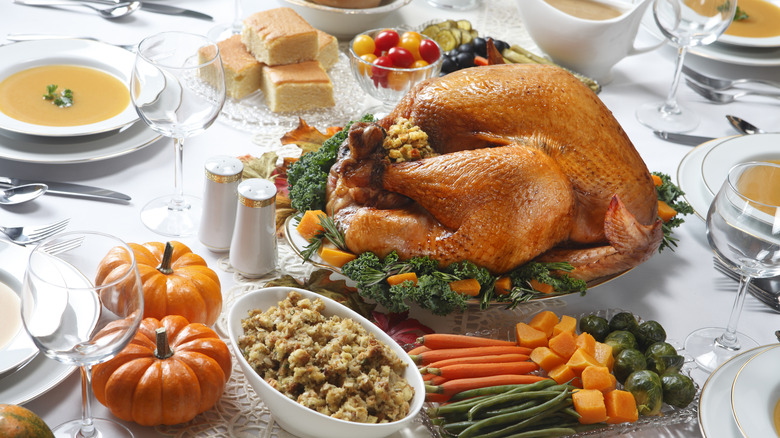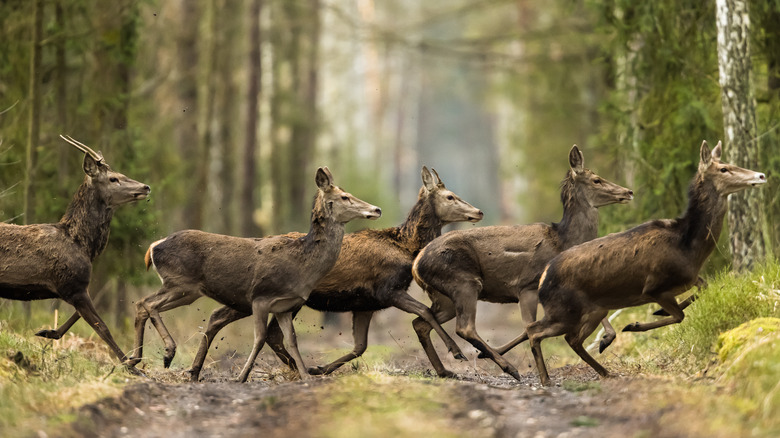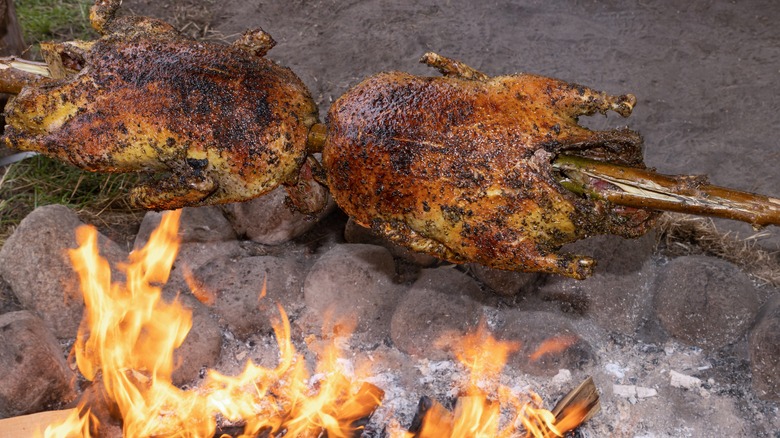What People Might've Actually Eaten At The First Thanksgiving
Most Americans know exactly what to expect when they sit down to a Thanksgiving meal. Sure, there are countless interpretations of roast turkey, mashed potatoes, and pumpkin pie, but for the most part, we generally have a good idea of what we'll be eating on the fourth Thursday of November, no matter who is hosting. If Americans would have stayed true to what was actually served on the very first Thanksgiving back in 1621, the holiday meal would look completely different.
The first Thanksgiving took place between the Pilgrims who settled in Plymouth County, Massachusetts and the Wampanoag tribe, and took place over a period of three days. Very few of the items set on a modern Thanksgiving table were present, and if they were, they weren't in the form that you'd be used to seeing them in. For example, while pumpkins may have been part of the meal, it certainly wasn't in the form of a pie. Other dishes were completely absent, like mashed potatoes. In fact, spuds hadn't even appeared on North American soil yet. As far as the star of the show, turkey, it's true that the area of Plymouth was plentiful with the large birds but what made the guests' eyes widen with anticipation was likely the large amount of venison that was present.
Local and seasonal was the name of the game
Only two written accounts exist of the time that is known as the first Thanksgiving and they were written by Edward Winslow and William Bradford. Winslow describes the arrival of the Native Americans who provided five deer, and the abundance of fowl (likely ducks, geese, swans) that the Pilgrims were able to procure. Bradford spoke of the fall harvest they experienced and mentioned cod, bass, wild turkeys, and heirloom corn.
Culinary historians have largely filled in the gaps as to what was most likely enjoyed by the large group of people in their three days of eating and celebrating. Considering the time of year and the location of Plymouth, fall harvest likely included onions, beans, cabbage, carrots, and corn which was likely made into cornmeal to make breads and mush. Seasonal fruits were blueberries, plums, grapes, gooseberries, and cranberries. Sugar was not plentiful during this time so cranberries were hardly made into the sauce or relish we are familiar with.
The Wampanoags also likely introduced the Pilgrims to local seafood like mussels, lobster, and eels, and taught them how to forage foods from the surrounding forests such as chestnuts and walnuts. The food was definitely plentiful for the roughly 90 Wampanoags and 50 colonists who were present. While the foods may be different today, the sheer amounts of it have withstood the test of time.
A totally different Thanksgiving menu
We know those 17th century party animals didn't have mashed potatoes with their venison and mussels, but a lot more of what we know today as Thanksgiving "staples" weren't on the table either. Bread stuffing (or dressing) weren't filling the crevices of their roasted ducks and geese, but it's possible that those birds were instead stuffed with things like onions, herbs, and perhaps chestnuts.
The pies we love to eat at Thanksgiving like pecan, apple, and pumpkin didn't make an appearance, either. For one thing, wheat flour and butter for pie crust were ingredients that the colony did not have access to. In addition, there was no oven for baking yet in Plymouth County. Green bean casserole, candied yams, dinner rolls, and gravy would also all come later.
While the first Thanksgiving certainly went down in history and is a significant holiday today for millions, it would be over 200 years after that occasion when it would be celebrated on an annual basis. In 1863 a woman named Sarah Josepha Hale convinced President Lincoln that a nationwide Thanksgiving celebration was needed to unite the country after the divisive Civil War. He declared it an official holiday and America has celebrated ever since.



